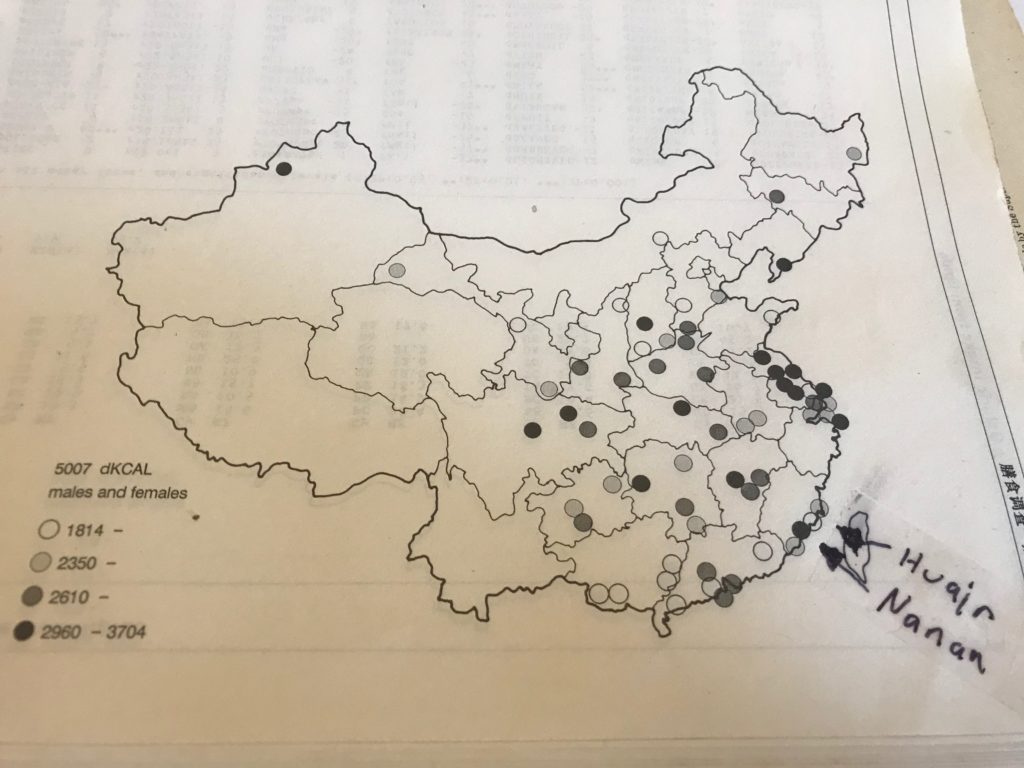Another interesting finding of “Diet, Life-style and Mortality in China” is that there was a huge variation in caloric consumption in different regions of China without a corresponding difference in body weights. This is the most notable in two neighboring areas – Nanan and Huian – two places on the Southeast coast of China with a diet consisting mainly of rice, sweet potatoes and fish. For reasons that are unclear, perhaps poverty or crop failure, the people of Huian were consuming only half the calories of neighboring Nanan at the time of the dietary survey – mostly due to a lower consumption of sweet potatoes – and yet were heavier and had a (slightly) higher average BMI.
| Nanan | Huian | |
| Calories Per Day | 3578 | 1814 |
| Weight of Average Male (Pounds) | 121.8 | 124.7 |
| Calories Per Pound | 29.4 | 14.5 |
| BMI | 20.3 | 21 |
| Rice (g/day) | 385.8 | 387.6 |
| Starchy Tubers (g/day – Most Likely Sweet Potatoes) | 560.9 | 35.3 |
| Vegetables (g/day) | 156.5 | 37.4 |
| Dried Vegetables (g/day) | 30.7 | 2 |
| Fruit (g/day) | 0 | 0 |
| Starch and Sugar (g/day) | 0.5 | 2.3 |
| Nuts (g/day) | 0 | 1.2 |
| Milk and Dairy (g/day) | 0 | 0 |
| Eggs (g/day) | 0.9 | 0.8 |
| Meat (g/day – Most Likely Pork) | 26.7 | 5.5 |
| Fish (g/day) | 11 | 45.3 |
| Rapeseed Oil (g/day) | 0 | 0 |
| Other Oils (g/day) | 8.6 | 1.8 |
| Soy Sauce (g/day) | 6.2 | 8.5 |
| Salt (g/day) | 16.9 | 8.7 |
| Other Foods (g/day) | 18.6 | 0.4 |
As you can see, this is a pretty thorough dietary snapshot. The people of Nanan ate white rice with plentiful sweet potatoes and vegetables, a little meat and salt and not much else. The people of Huian ate white rice with a very small amount of vegetables, some fish and not much else. The people of Huian ate half the calories that the people of Nanan did but on average were heavier. The caloric consumption listed in the study is indexed to a male doing very light physical labor, such as office work, so differences in the amount of physical labor being done can’t explain the discrepancy.
Understand that the people of Huain weren’t starving. 1800 calories is a decent amount for a 125 lb office worker. That’s more calories per pound than an average American eats now. What is really amazing is how much the people of Nanan were eating. A stupefying 29 calories per pound per day. That’s the equivalent of a 200 pound man consuming 5800 calories per day. And the caloric consumption reported in the study was for the least active type of person, someone employed in office work or fixing electronics.

Let’s try to draw some conclusions from this. First off, in neither area are sugar or vegetable oils eaten to any significant degree and in both areas the people are slim. This is very much what we would expect according to The ROS Theory of Obesity. Secondly, there is clearly no relationship between caloric consumption and weight between Nanan and Huain. This lack of relationship extends throughout China, I’ve merely picked out the most dramatic example. Even if Huain is only experiencing a temporary caloric drop due to crop failure, you would expect them to have lost a few pounds compared to Nanan if the idea is that the primary driving factor in weight gain or loss is calories in vs. calories out. I mean, the male office workers of Huain were eating an extraordinary amount – 3600 calories is a lot for a 120 pound sedentary individual! If calories in Vs. calories out is the predominate factor in weight gain or loss, it should only take a matter of a week or two at these caloric levels for the people of Nanan to become heavier than the people of Huain. But that’s not what happened.
